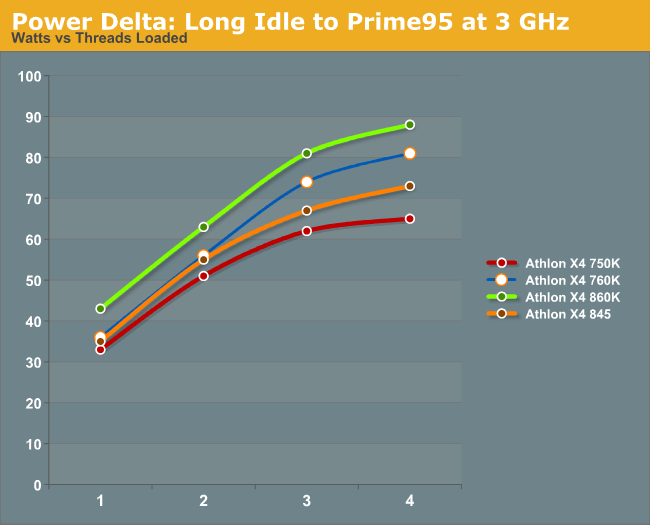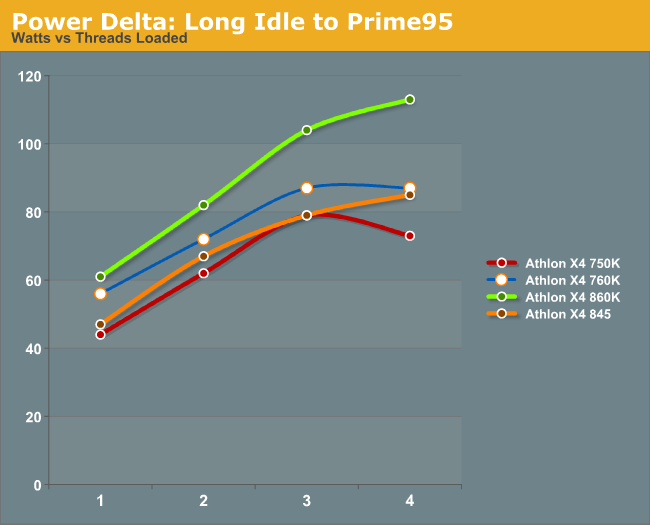AMD Carrizo Part 2: A Generational Deep Dive into the Athlon X4 845 at $70
by Ian Cutress on July 14, 2016 9:00 AM ESTPower Consumption
Power consumption was tested on the system while in a single MSI GTX 770 Lightning configuration with a wall meter connected to the power supply. This power supply is 80PLUS rated, and as I am in the UK on a 230-240 V supply, leads to ~75% efficiency > 50W, and 90%+ efficiency at 250W, suitable for both idle and multi-GPU loading. This method of power reading allows us to compare the power management of the UEFI and the board to supply components with power under load, and includes typical PSU losses due to efficiency.
Our Power Consumption tests have changed slightly since our last review as we are testing out new ways to represent the power used by the CPU and the system. The current three standard tests start with a system at long idle, meaning that the OS turns off the monitor and enters a lower power state without going into S3. We then move into a standard idle state on the desktop, with no software running but the desktop on display. The system is then moved into high performance mode, and we run a one-minute OCCT test to identify peak power consumption.
Due to extended requests, our power consumption numbers also use Prime95 to load the system. We use Prime95's peak power consumption mode, testing 1/2/3/4 thread consumption at the wall with our power meter. P95 hits the peak power relatively quickly, making this a straightforward test to include. For CPUs above 4 threads, we typically manage powers of two, half the CPU, and the full CPU to get an accurate picture.
For this review, we performed the power analysis for all four main CPUs at the 3 GHz frequency (using automatic voltage on the motherboard), as well as at stock frequencies. The values shown are delta values to the long idle power consumption, due to power delivery variations.
Generational Power Consumption at 3 GHz
All four processors have a 2-3W difference moving from a long idle to an idle state, however it is clear that our Carrizo CPU, which we stated is well outside its normal efficiency window at the beginning of this review, has a very good response during OCCT loading.

These results are within 3-4W of the full loading provided by Prime95 as well. If we analyze the per core jumps from moving up the threads using Prime95, there are some interesting numbers to pick out.

All the processors increase their power consumption by ~20W when both modules are loaded, when moving from 1 core loading to 2 core loading. When moving to 3/4 core loading, it is obvious that as both modules are already running at high frequency, a smaller amount of power is needed for each to enable the second thread.
Power Consumption at Stock
For those keeping track, we were not able to source identical TDP rated processors for this test. While the Carrizo based Athlon is 65W, the other processors are at the 95W/100W level. This makes total power consumption numbers relatively processional, and it becomes interesting looking into how close each processor gets to its TDP.
In our testing, the X4 845 seems to go beyond its 65W TDP, pushing almost another 9W through our power meter. This is only 8W away from the X4 750K, which should be 35W ahead. However, it would seem that for the X4 845, P95 draws an extra 15W compared to OCCT, but for the X4 750K, it draws 10W less, showing how difficult it can be to retain consistency. It is worth noting that TDP ratings are difficult to interpret in this way - the processors coming out of the fabs will have a statistical variation to their operating voltage, and this differs between samples. A good sample of a high TDP compared to a bad sample of a low TDP might seem to generate an interesting story, however without having access to several dozen units it can be strained to draw many conclusions.

Looking at the Prime95 core-loading numbers, we see a similar pattern to what happened at 3 GHz, despite the X4 760K getting the same power reading for 3/4 core loading and the X4 750K actually decreasing in power with four loaded threads.










131 Comments
View All Comments
owan - Thursday, July 14, 2016 - link
A nice little pop over the previous generation and its still woeful compared to its direct competition from intel. I wonder why AMD even bothered with this product, Intel has a complete stranglehold on the mobile market and AMD's design wins are few and far between. Surely some of the architectural changes could have been rolled into a replacement for their incredibly stale AM3+ products, which have by now become completely irrelevant. I mean, we all know Zen is coming (and I hope its good) but something in the meantime would probably have done more for their mind share than a mobile part.AndrewJacksonZA - Thursday, July 14, 2016 - link
"I wonder why AMD even bothered with this product"Yeah, pretty much what I've been thinking with AMD's CPU launches for a while now. *Surely* they can't be making money on their CPUs compared to how much they spend on researching, testing, producing and then marketing them?
(Unless there's a market that's low-profile in the media but is lucrative for AMD - perhaps the low budget market in Asia?)
patel21 - Thursday, July 14, 2016 - link
I'm from Asia, India. And here too people are smart enough to ignore AMD even in really low budget systems. And really we still have a complete PC with P4 or C2D easily available around 100$jospoortvliet - Thursday, July 14, 2016 - link
Compared to a p4 these amd cpu's are amazing... remember that in the time of the P4, amd made the faster more power efficient cpu's.mr_tawan - Friday, July 15, 2016 - link
P4 or C2D are worse than every current AMD cpus on the market .... in one or another aspect.BlueBlazer - Friday, July 15, 2016 - link
It is called "progress". Both Intel Pentium4 and Intel Core 2 Duo are already out of production years ago. Also it was Intel's Core 2 Duo that blew away AMD back into the stone age a decade ago, and since then AMD has never recovered. AMD's QuadFather FX and Barcelona (especially the TLB bugged ones) are the worst CPUs of their era (quite often was much slower than previous generation overall).bananaforscale - Friday, July 15, 2016 - link
P4? Ew. :P (I have a P4D in the other room, it's not really preferable to anything. That if anything is a dead end.)nandnandnand - Thursday, July 14, 2016 - link
AMD is good in laptops. It will be better when Zen is out. Zen on the desktop may be good depending on the benchmarks and price.mr_tawan - Friday, July 15, 2016 - link
I'm from Asia, Thailand. AFAIK AMD is pretty popular among internet cafe' (or should I say... game center instead ?).BlueBlazer - Friday, July 15, 2016 - link
Over here, hardly see AMD being used in internet cafes.